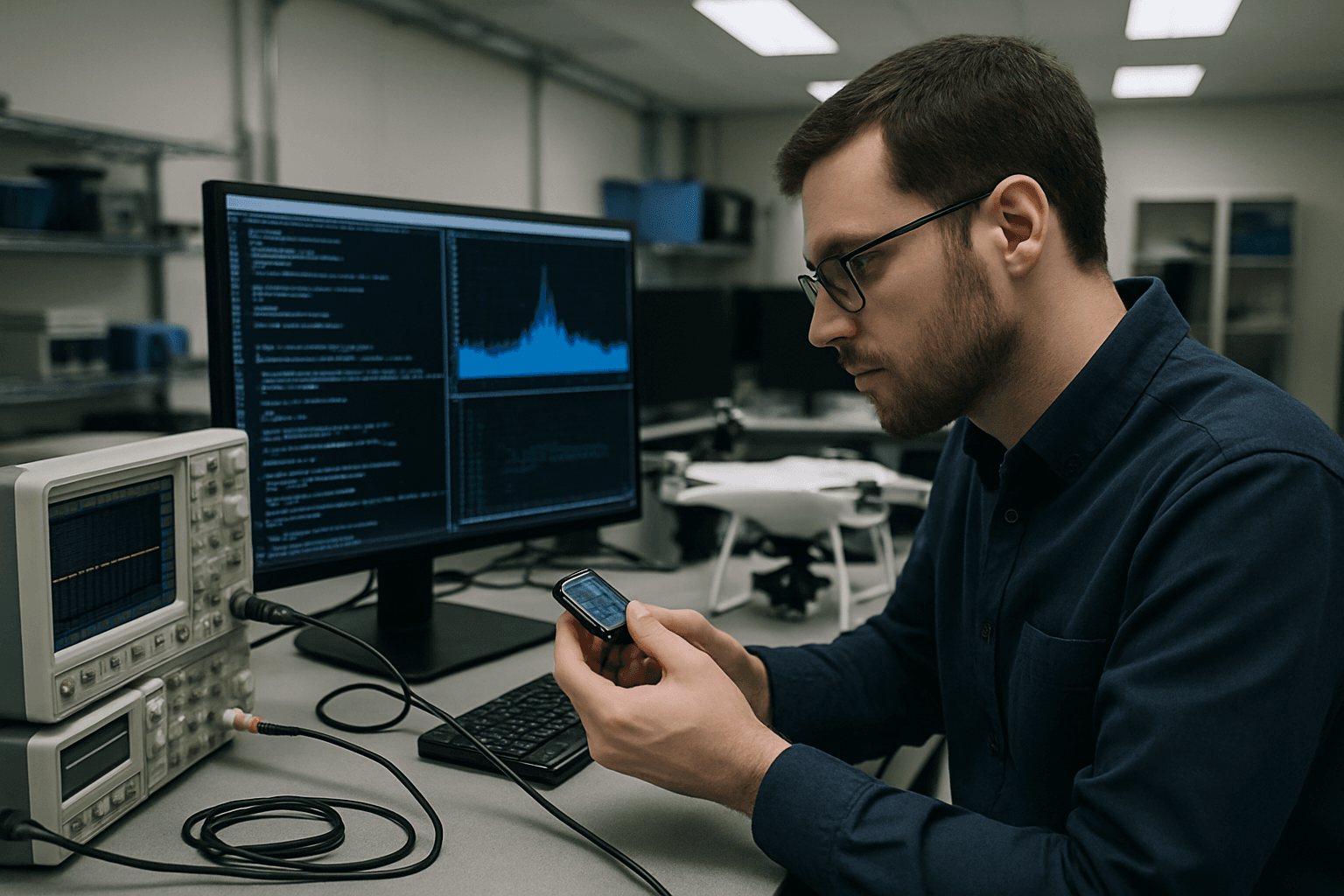Drone technology has rapidly evolved, becoming integral to various sectors, from military operations to commercial deliveries. However, this increasing reliance has also exposed vulnerabilities, notably drone spoofing. Drone spoofing, a form of electronic deception, involves manipulating a drone’s navigation and communication systems. Attackers exploit vulnerabilities in GPS and other navigational aids to mislead a drone’s location, potentially leading to unauthorized access, data theft, or even physical harm. This article delves into the intricacies of drone spoofing, its implications, mitigation strategies, and the legal considerations surrounding this growing threat.
Understanding Drone Spoofing
Drone spoofing is a type of cyberattack where false signals are transmitted to a drone’s GPS receiver, causing it to misinterpret its location. Instead of jamming the GPS signal, which would simply cause the drone to lose its GPS connection, spoofing provides a false signal that appears to be a legitimate GPS signal. This can cause the drone to fly off course, land in an unintended location, or even be taken over completely by the attacker.
How GPS Spoofing Works
GPS spoofing involves several key steps:
- GPS Signal Monitoring: The attacker first monitors the actual GPS signals being received by the target drone.
- False Signal Generation: The attacker then generates counterfeit GPS signals using specialized equipment, such as software-defined radios (SDRs).
- Overpowering Genuine Signals: The spoofed signals are transmitted with a higher signal power than the real GPS signals, effectively overpowering them.
- Drone Behavior Manipulation: The drone’s GPS receiver locks onto the stronger, fake signals, causing it to misinterpret its location and follow the attacker’s commands.
The Rise of Drone Spoofing Threats
Recent years have witnessed a surge in drone spoofing incidents, attributed to the increasing accessibility and affordability of drone technology. Sophisticated spoofing techniques have emerged, enabling attackers to manipulate drones with precision and stealth. High-profile incidents, such as the hijacking of military drones and the disruption of commercial air traffic, have underscored the urgency of addressing this escalating threat. The proliferation of drones in various sectors, coupled with the lack of robust security measures, has created a fertile ground for spoofing attacks.
Implications of Drone Spoofing
The implications of drone spoofing are far-reaching, affecting various sectors, including military, commercial, and private domains. A successful GPS spoofing attack may have dangerous consequences as it can divert the course of the flight or can cause a drone to crash. Through spoofing, the safety feature of “Geo-fencing” can also be bypassed and thus the targeted drone can be made to violate no-flying zones
Military Applications
In the military sector, drone spoofing poses a significant threat to national security. Military drones are used for surveillance, reconnaissance, and even armed combat. If an enemy can spoof the GPS signals of a military drone, they could potentially hijack it, causing it to crash or be used for malicious purposes. One of the most notable cases occurred in 2011, when a U.S. RQ-170 Sentinel drone was allegedly intercepted by Iranian forces through GPS spoofing techniques. By transmitting counterfeit GPS signals, the attackers manipulated the UAV’s navigation system, causing it to deviate from its intended flight path and land in a controlled area.
Commercial Applications
In the commercial sector, drone spoofing can disrupt deliveries, damage infrastructure, and compromise sensitive data. For example, a delivery drone could be spoofed to deliver its package to the wrong address, or a drone inspecting a bridge could be spoofed to crash into the structure. The effects of a GPS spoofing attack could be devastating, including a collision, crash or even theft of the UAV.
Private Sector
In the private sector, drone spoofing can be used to invade privacy, steal data, or even cause physical harm. For example, a drone could be spoofed to fly over private property and record video, or a drone could be spoofed to drop a dangerous object on someone’s head. Such attacks not only threaten the normal UAV operation but may also result in severe economic losses and safety hazards.
Mitigation Strategies and Best Practices
To counter the growing threat of drone spoofing, a multi-faceted approach is necessary. Implementing robust security measures, such as encryption and authentication protocols, can enhance the resilience of drone systems against spoofing attacks. Regular software updates and patches are crucial to address vulnerabilities and keep pace with evolving spoofing techniques.
Technical Countermeasures
- Encryption and Authentication: Employing cryptographic techniques to authenticate GPS signals and encrypt communication channels can prevent attackers from injecting false data. Cryptographic authentication techniques, such as spread-spectrum modulation or signal watermarking, aim to validate genuine satellite transmissions at the protocol level.
- Inertial Measurement Units (IMUs): Integrating IMUs can provide a redundant navigation system that is not susceptible to GPS spoofing. Consistency check of an inertial navigation system (INS) and GPS was proposed for detecting GPS spoofing
- Multi-Sensor Fusion: Combining data from multiple sensors, such as cameras, LiDAR, and radar, can provide a more accurate and reliable navigation solution.
- Anomaly Detection: Implementing algorithms to detect anomalous behavior in GPS signals can help identify and mitigate spoofing attacks. AI-Powered Anomaly Detection, incorporates sophisticated machine learning algorithms to detect anomalies in drone behavior and communication patterns
- Real-Time Kinematic (RTK) GPS: Using RTK GPS can improve the accuracy of GPS measurements, making it more difficult for attackers to spoof the signal.
- Vision-Based Navigation: Utilizing computer vision techniques to navigate based on visual landmarks can provide an alternative to GPS-based navigation.
Operational Procedures
- Regular Software Updates: Keeping drone software up-to-date with the latest security patches is essential to address known vulnerabilities.
- Pilot Training: Training drone pilots to recognize and respond to potential spoofing attacks can help mitigate the risks. Awareness and education play a pivotal role in mitigating the risks associated with drone spoofing. Stakeholders must be informed about the potential threats and the measures they can take to safeguard their drone operations.
- Geofencing: Establishing digital boundaries using geofencing technology to prevent drones from entering restricted areas.
- Pre-Flight Checks: Performing thorough pre-flight checks to ensure that all systems are functioning correctly can help identify potential problems before they become serious.
Emerging Technologies in Anti-Spoofing
- Quantum Key Distribution (QKD): QKD offers the potential for unconditionally secure key exchange, even against quantum computer attacks.
- Collaborative Verification Networks: By leveraging the collective intelligence of multiple drones and ground stations, collaborative networks can provide enhanced spoofing detection
- AI-Driven Predictive Spoofing Detection: Advanced AI models are being developed to predict and preempt spoofing attempts
Legal and Regulatory Landscape
The legal and regulatory landscape surrounding drone spoofing is still evolving. However, several existing laws and regulations may apply.
International Laws
Internationally, the use of GPS spoofing is governed by the International Telecommunication Union (ITU). The ITU regulates the use of radio frequencies, including those used by GPS. It is illegal to transmit signals that interfere with legitimate GPS signals.
National Laws
Many countries have laws in place that prohibit the use of GPS spoofing. For example, in the United States, the Communications Act of 1934 prohibits the transmission of false or misleading signals. In the United Kingdom, the Wireless Telegraphy Act 2006 prohibits the use of radio equipment to cause interference.
Drone-Specific Regulations
Some countries have also implemented drone-specific regulations that address the issue of spoofing. For instance, some regulations require drones to have anti-spoofing technology installed, while others prohibit the operation of drones in certain areas where spoofing is more likely to occur.
Legal Issues with Counter Drone Technology
There are a bunch of laws already in place which currently prohibit counter drone technology from being used or create liability when they are used. Federal law establishes a public right of transit through navigable airspace and vests the FAA with authority to ensure the safety of aircraft and the efficient use of airspace. Before a state or local government entity creates a law or tries to enforce a counter drone law against unmanned aircraft, they need to realize that the operation of a drone is a federal right.
Ethical Considerations
The use of GPS spoofing also raises several ethical concerns. While it can be used to protect against malicious drones, it can also be used to disrupt legitimate drone operations. It is important to consider the potential consequences of using GPS spoofing before deploying it.
The Future of Drone Security
As drones continue to permeate various sectors, the importance of robust security measures cannot be overstated. The future of drone security lies in the development of advanced technologies, such as blockchain and artificial intelligence, to enhance the resilience of drone systems against spoofing attacks. Innovation in drone design, including the integration of secure communication channels and anti-spoofing mechanisms, can further mitigate the risks associated with drone spoofing.
AI-Powered GPS Spoofing
AI can be used to create more sophisticated GPS spoofing attacks that are more difficult to detect. For example, AI can be used to learn the patterns of GPS signals and then generate fake signals that closely resemble the real ones.
Quantum-Secure GPS Systems
Quantum-secure GPS systems use quantum cryptography to protect GPS signals from spoofing attacks. Quantum cryptography is a method of encryption that is based on the laws of quantum mechanics. It is considered to be unbreakable, even by the most powerful computers.
Integration with Cyber Warfare Systems
GPS spoofing can be integrated with cyber warfare systems to create more powerful and effective attacks. For example, GPS spoofing can be used to disable the navigation systems of enemy drones, while other cyberattacks can be used to steal data or disrupt communications.
Autonomous Spoofing Drones
Autonomous spoofing drones can be used to automatically spoof GPS signals in a given area. This can be used to protect sensitive locations from drone attacks or to disrupt enemy drone operations.
Conclusion
Drone spoofing poses a significant threat to the security and privacy of individuals and organizations alike. By understanding the intricacies of this emerging threat and implementing robust security measures, stakeholders can mitigate the risks associated with drone spoofing. The future of drone security lies in collaboration, innovation, and education. By fostering a culture of security awareness and investing in advanced technologies, we can ensure the safe and responsible use of drone technology in the years to come.





